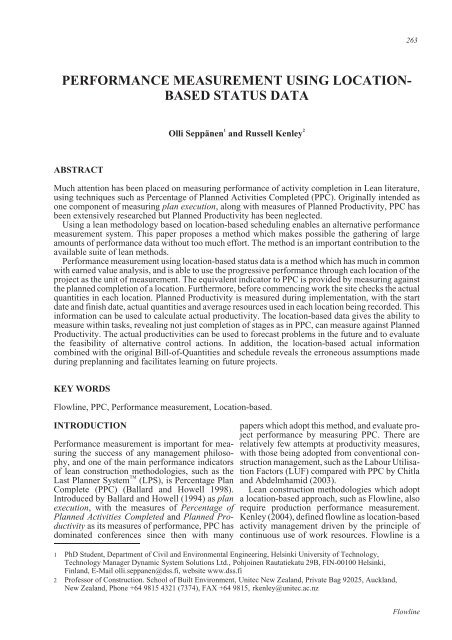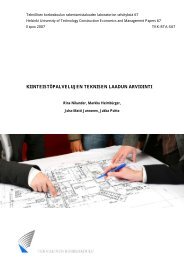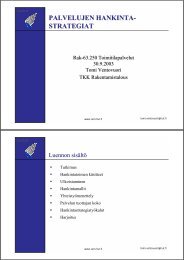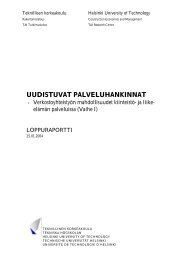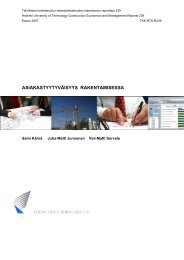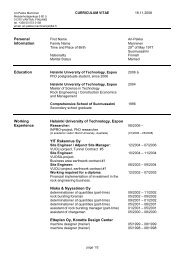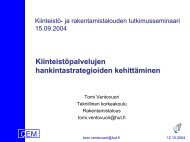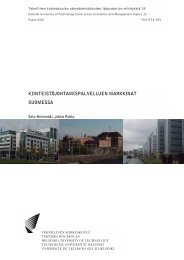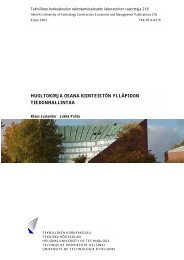performance measurement using location- based status data
performance measurement using location- based status data
performance measurement using location- based status data
You also want an ePaper? Increase the reach of your titles
YUMPU automatically turns print PDFs into web optimized ePapers that Google loves.
263PERFORMANCE MEASUREMENT USING LOCATION-BASED STATUS DATAOlli Seppänen 1 and Russell Kenley 2ABSTRACTMuch attention has been placed on measuring <strong>performance</strong> of activity completion in Lean literature,<strong>using</strong> techniques such as Percentage of Planned Activities Completed (PPC). Originally intended asone component of measuring plan execution, along with measures of Planned Productivity, PPC hasbeen extensively researched but Planned Productivity has been neglected.Using a lean methodology <strong>based</strong> on <strong>location</strong>-<strong>based</strong> scheduling enables an alternative <strong>performance</strong><strong>measurement</strong> system. This paper proposes a method which makes possible the gathering of largeamounts of <strong>performance</strong> <strong>data</strong> without too much effort. The method is an important contribution to theavailable suite of lean methods.Performance <strong>measurement</strong> <strong>using</strong> <strong>location</strong>-<strong>based</strong> <strong>status</strong> <strong>data</strong> is a method which has much in commonwith earned value analysis, and is able to use the progressive <strong>performance</strong> through each <strong>location</strong> of theproject as the unit of <strong>measurement</strong>. The equivalent indicator to PPC is provided by measuring againstthe planned completion of a <strong>location</strong>. Furthermore, before commencing work the site checks the actualquantities in each <strong>location</strong>. Planned Productivity is measured during implementation, with the startdate and finish date, actual quantities and average resources used in each <strong>location</strong> being recorded. Thisinformation can be used to calculate actual productivity. The <strong>location</strong>-<strong>based</strong> <strong>data</strong> gives the ability tomeasure within tasks, revealing not just completion of stages as in PPC, can measure against PlannedProductivity. The actual productivities can be used to forecast problems in the future and to evaluatethe feasibility of alternative control actions. In addition, the <strong>location</strong>-<strong>based</strong> actual informationcombined with the original Bill-of-Quantities and schedule reveals the erroneous assumptions madeduring preplanning and facilitates learning on future projects.KEY WORDSFlowline, PPC, Performance <strong>measurement</strong>, Location-<strong>based</strong>.INTRODUCTIONPerformance <strong>measurement</strong> is important for measuringthe success of any management philosophy,and one of the main <strong>performance</strong> indicatorsof lean construction methodologies, such as theLast Planner System TM (LPS), is Percentage PlanComplete (PPC) (Ballard and Howell 1998).Introduced by Ballard and Howell (1994) as planexecution, with the measures of Percentage ofPlanned Activities Completed and Planned Productivityas its measures of <strong>performance</strong>, PPC hasdominated conferences since then with manypapers which adopt this method, and evaluate project<strong>performance</strong> by measuring PPC. There arerelatively few attempts at productivity measures,with those being adopted from conventional constructionmanagement, such as the Labour UtilisationFactors (LUF) compared with PPC by Chitlaand Abdelmhamid (2003).Lean construction methodologies which adopta <strong>location</strong>-<strong>based</strong> approach, such as Flowline, alsorequire production <strong>performance</strong> <strong>measurement</strong>.Kenley (2004), defined flowline as <strong>location</strong>-<strong>based</strong>activity management driven by the principle ofcontinuous use of work resources. Flowline is a1 PhD Student, Department of Civil and Environmental Engineering, Helsinki University of Technology,Technology Manager Dynamic System Solutions Ltd., Pohjoinen Rautatiekatu 29B, FIN-00100 Helsinki,Finland, E-Mail olli.seppanen@dss.fi, website www.dss.fi2 Professor of Construction. School of Built Environment, Unitec New Zealand, Private Bag 92025, Auckland,New Zealand, Phone +64 9815 4321 (7374), FAX +64 9815, rkenley@unitec.ac.nzFlowline
264 Performance <strong>measurement</strong> <strong>using</strong> <strong>location</strong>-<strong>based</strong> <strong>status</strong> <strong>data</strong>management philosophy for construction production,otherwise known as: ‘Line-of-balance’,‘Construction planning technique’, ‘Vertical ProductionMethod’, ‘Time-Location Matrix model’,‘Time Space Scheduling method’, ‘Disturbancescheduling’ and ‘Horizontal and vertical logicscheduling for multistory projects’ (Harris andIoannou 1998). Kenley (2004) reintroduced themost evocative term for a Lean thinker, that of‘Flowline’ (from Mohr 1991) 3 .Chitla and Abdelmhamid (2003) stated “ThePercent Plan Complete (PPC) is a metric thatreflects the effectiveness of production planningand the reliability of workflow from one trade toanother." This is an interesting definition and onewhich highlights a concern in the interpretation ofworkflow, yet ignores the original role for productivity<strong>measurement</strong>. An assumption within <strong>location</strong>-<strong>based</strong>Flowline production management isthat workflow is not only predictable, but plannedand continuous—not interrupted. This is not arequirement of LPS, which is a production controlmethod rather than a planning tool and uses PPC“to measure the quality of the commitments madeand the reliability of workflow, the number ofcompleted assignments is expressed as a ratio ofthe total number of assignments made” (Chitlaand Abdelmhamid 2003) in a given week orperhaps daily (Ballard and Howell 2003).However, the <strong>location</strong>-<strong>based</strong> strategy providesone great advantage over activity-<strong>based</strong> systems.This advantage is that the setting of daily taskassignments and completion can be replaced withcommitment to a chain of progress through <strong>location</strong>s—requiringequal prior commitment as inLPS—providing completion of scheduled workflowthrough <strong>location</strong>s. This is an important point,because the key philosophical difference isbetween committing to an activity as a once offventure, and committing to a chain of activitiesthrough a sequence of <strong>location</strong>s. The latter is amuch greater and more effective commitment forthe delivery of lean principles on projects.The key difference here is that PPC is a targetcompletion <strong>performance</strong> measure of plan execution—butprovides little information with regardsto the rate of production. One criticism could bethat deliberately slowing the work and setting fewtasks would lead to improved PPC, but slowedproduction. As with Earned Value Analysis(Kenley 2003), <strong>performance</strong> <strong>measurement</strong>requires consideration of time as well as completion.Yet Planned Productivity was always anintended measure of Plan Execution (Ballard andHowell 1994).Flowline provides a unique solution to thisproblem, as the completion of work within <strong>location</strong>sequates to PPC and the rate of productionaccording to the flowline schedule—completewith continuity and work-flow—provides theplanned productivity <strong>performance</strong> information.Furthermore, the knowledge of planned, andactual, quantity <strong>data</strong>, production rates andresources; provides a great deal more informationthan is available with PPC. It must however benoted that making tasks ready, <strong>using</strong> lean methods,is assumed and necessary, however this isdone for chains of activities rather than discreteactivities, with commitment flowing through thechain.Thus, the adaptation of PPC into the flowlinemethodology and the development of a hybridsystem have the potential to improve the <strong>performance</strong>management of Lean construction projects.This paper proposes just such a hybrid<strong>performance</strong> management system which measuresPlan Execution.LOCATION-BASED SCHEDULING BASEDON LOCATION-BASED QUANTITIESThe proposed system for <strong>performance</strong> <strong>measurement</strong>needs <strong>location</strong>-<strong>based</strong> quantities and aflowline schedule which has been <strong>based</strong> on thequantities as starting <strong>data</strong> (it is possible, but undesirable,to mimic scheduling by days). Quantityinformation is critical to get the benefits offlowline management, because the flowline planningmethod optimizes the production rates toachieve continuous resource flow. If quantities orproductivities are unknown, the durations areguesses at best and continuity can’t be assured.Quantities should be estimated by <strong>using</strong> theLocation Breakdown Structure of the project. TheLocation Breakdown Structure is a hierarchicalmodel of physical <strong>location</strong>s of the building.Depending on project type, Location BreakdownStructures can be very different. In normal buildingprojects, however, the first hierarchy level iscomposed of buildings or structurally independentparts of buildings, the next hierarchy level hasfloors and, for suitable projects, the floors are subdividedinto rooms, apartments or other spaces.Each activity item and quantity has a logical hierarchylevel where it is most meaningful to be calculated.For example, quantities of the structure3 Harris and Ioannou (1998) also identified the terms used in engineering construction such as highways, pipelinesand tunnels, as ‘Time versus distance diagrams’, ‘Linear balance charts’, ‘Velocity diagrams’ and ‘Linearscheduling’. Kang, and Park, et al. (2001) also identify ‘Horizontal and vertical scheduling’, and ‘Multiplerepetitive construction process’—but aimed these at the specific case of vertical replication repeated in multiplebuildings.Proceedings IGLC-13, July 2005, Sydney, Australia
Olli Seppänen and Russell Kenley 265are meaningful at the floor level of accuracy whilefinishes and fittings can be calculated for eachindividual room. Finer detail is more suitable formeasuring completion by <strong>location</strong>. Longer durationactivities at the higher <strong>location</strong> breakdownwould require percentage completion.To plan production rates and to get an idea ofresource needs, quantities can be transformed intodurations in a <strong>location</strong> by <strong>using</strong> productivityinformation. The usual problem is that for subcontractedwork in commercial construction, productivity<strong>data</strong> is often not available 4 . In Finland, thisissue has been addressed by developing acommon productivity <strong>data</strong>base by a joint effort ofconstruction companies (Olenius, Koskenvesa &Mäki 2000). If productivity <strong>data</strong> is not available,durations have to be estimated <strong>based</strong> on the planner’sknowledge and expertise of duration andresource use. This allows a measure of productivityto be calculated backwards from quantity andresource use and can be refined in future projectsby the use of <strong>performance</strong> <strong>measurement</strong> systems.One common criticism against <strong>using</strong> productivityestimates, made within the Lean Constructionliterature, is that waste has been already includedin current estimates. On the other hand, there isvariability associated with productivities. In <strong>location</strong>-<strong>based</strong>planning, the idea is to set realistic productionrate targets <strong>based</strong> on quantities, resourceavailability and a realistic but tight estimate ofproductivity (this contrasts with unfortunatecommon practice, which is to allow an approximateduration, such as a number of days, for anactivity without due regard to the specific context).This in fact removes a great deal of surprisefrom the variation in production: it ceases to beunexpected. Unexpected variation can beaccounted for by <strong>using</strong> simulation to assess therisk of interference to the succeeding trades(Kankainen & Seppänen 2003). If productivity isfound to be incorrect during the project, therequired production rate can be achieved byadding or decreasing resources.The main benefit of <strong>using</strong> <strong>location</strong>-<strong>based</strong> quantitiesis to be able to plan continuous work flowwith even or balanced resource use for subcontractorsand direct labor. Just drawing task lineswith parallel slopes is not enough, because itrequires the implicit assumption that either quantitiesare the same in each <strong>location</strong> or thatresources are added or decreased <strong>based</strong> ondemand in each <strong>location</strong> (this is a common errormade by those that consider linear scheduling tobe simplistic). This assumption is dangerousbecause it may damage the potential benefits offlowline production management with resultantand unexpected fluctuating resource needs.Figure 1 shows an example of flowline schedulingDSS Ltd. Line-of-balance view Figure 1Foreperson: Russell Kenley version 5.6.2005 15:55 Planner: O lli SeppänenTaso2 MayJunJulAug2122232425262728293031Mo Tu We Th Fr Mo Tu We Th Fr Mo Tu We Th Fr Mo Tu We Th Fr Mo Tu We Th Fr Mo Tu We Th Fr Mo Tu We Th Fr Mo Tu We Th Fr Mo Tu We Th Fr Mo Tu We Th Fr Mo Tu We Th325TASK1 5TASK21TASK243Project startTASK1 31TASK1 43TASK22TASK1 22TASK21TASK1 1Plan: Actual: Forecast:Design modeDYNAProject v2.2.0100TASK2Figure 2: Forecasting production after <strong>performance</strong> variationRegistration <strong>data</strong>: Olli Seppänen / DSS Ltd.4 Experience indicates this statement is not true in engineering construction, where production rates are expected.Flowline
266 Performance <strong>measurement</strong> <strong>using</strong> <strong>location</strong>-<strong>based</strong> <strong>status</strong> <strong>data</strong>with two lines having the same quantities. Task 1forces the line to have the same slope in each <strong>location</strong>,while task 2 has different quantities but usesthe same resources in each <strong>location</strong>, and thus theslope of the line varies. The small numbers at thetop of each of the line segments of task 1 show theresource needs for each <strong>location</strong>. Both tasks havethe same total duration over the project. However,task 1 will probably not be implemented asplanned because of fluctuating resource needs. Itis unlikely that the subcontractor will providemore men exactly as needed to achieve <strong>location</strong><strong>based</strong>production rate requirements. On the otherhand, task 2 can be implemented as planned if thesubcontractor provides enough resources to consistentlyachieve the aligned production rate. By<strong>using</strong> <strong>location</strong>-<strong>based</strong> <strong>performance</strong> <strong>measurement</strong> itis then easy to estimate if the production rateshould be adjusted by increasing or decreasingresources. This results in much fewer adjustmentsand gives the subcontractor confidence that theycan continue with the same resources until the endof their contract.GETTING ACTUAL DATA DURINGPRODUCTIONActual <strong>performance</strong> <strong>data</strong> is needed for three purposes:1) to evaluate immediate need for control actions,2) to learn the correct productivity rate for futureprojects, and3) to estimate the productivity effects of controlactions, deviations and process improvementinitiatives.To achieve the information needed for productioncontrol, the <strong>performance</strong> <strong>data</strong> needs to be obtainedalmost in real-time and to correspond with theoriginal plan. In <strong>location</strong>-<strong>based</strong> scheduling, themost accurate unit of scheduling is the <strong>location</strong>.Thus it makes sense to measure <strong>performance</strong> ineach <strong>location</strong> as opposed to measuring <strong>performance</strong>as function of fixed time periods (withpercentage completion).To be able to calculate the <strong>performance</strong> measuresdescribed in the next section, the followinginformation should be gathered in each <strong>location</strong>for each task:• actual quantities• actual resources• actual shift length and days off• actual start and finish dates• actual deviationsBased on the author’s Finnish experiences on realcase studies, the monitoring should be done atleast weekly to get accurate enough results. If themonitoring is weekly instead of real-time, therewill be minor <strong>measurement</strong> errors in each <strong>location</strong>because it is not possible to know the exact timewhen the crew finished in a <strong>location</strong> or how long acrew worked on any given day. However, becausethere are many <strong>location</strong>s in a typical project, these<strong>measurement</strong> errors will cancel each other out.The time needed to get this information is abouttwo hours a week on a 15,000 m2 project(Seppänen & Aalto submitted). Monitoring dailywould give more accurate results but is very difficultto implement. Shifting recording requirementsto the work-crew may enable more accurate<strong>data</strong> recording.LOCATION-BASED PERFORMANCEMEASURESThe following <strong>performance</strong> measures can be calculated<strong>based</strong> on the <strong>data</strong> above:• total effective duration = actual finish date –actual start date – interruptions – days off• actual production rate (units / shift) = actualquantity / total effective duration• actual manhours / day = actual number of resources* actual shift length• actual resource consumption (manhours /unit) = (actual manhours / day) / actual productionrateActual production rate has lower starting <strong>data</strong>requirements. It just needs actual quantities withfinish dates and start dates for each <strong>location</strong>. Ifactual quantities are unknown, the planned quantitycan be substituted to arrive at a rough measure.The production rate doesn’t indicate whetherthe work has been more or less productive thanplanned but it can be used to forecast future progressif no control actions are taken and if the productioncontinues as before.Actual resource consumption is a much morepowerful measure but it requires the knowledge ofactual shift lengths and actual resources. Thismeans daily control of work to observe resourcefluctuations and work times. The measure can beused in planning control actions: how much moreresources (having the same productivity) orlonger days (with the same resources) are neededto achieve the original plan. The <strong>location</strong>-specificmeasures of a single task can be used to estimatethe variability of production rates and resourceconsumptions associated with a trade.FORECASTING FUTURE PROBLEMSUnlike PPC, which is an optimizing indicator(approaches 100% at optimum <strong>performance</strong>),actual production rates can be used to makeschedule forecasts. The schedule forecasts are calculated<strong>based</strong> on the assumption that the productioncontinues with the same production rate asProceedings IGLC-13, July 2005, Sydney, Australia
Olli Seppänen and Russell Kenley 267before, unless control actions are taken. This canbe shown graphically by plotting the actual lineand the forecast line into the flowline diagram.Graphically the forecast line is just an extrapolationof the actual line. CPM logic in the originalschedule can be used to estimate the effect onfuture trades by applying the same logic toforecast lines.In figure 2, a simple example is presented.There are three tasks in five <strong>location</strong>s. Task 1 hasstarted as planned but has been consistentlyslower than planned. Tasks 2 and 3 have beenstarted earlier than planned because project managementhas felt uncomfortable with long start-updelays (this habit of starting early and not actuallyimplementing the planned buffers has been discussedin Seppänen & Kankainen 2004). Task 2has actually been a bit faster than planned. Forecastshave been calculated <strong>based</strong> on actual productionrates and giving most weight to the lasttwo finished <strong>location</strong>s (weight of last <strong>location</strong> isthree times the weight of preceding <strong>location</strong>). Byapplying CPM Finish-to-Start relationship foreach <strong>location</strong>, the forecast lines of task 2 and task3 are forced to shift because predecessors are forecastedto be late. Unless task 1 can be acceleratedthere will be breaks in resource flow of tasks 2and 3.To properly answer the question what should bedone to correct the problem, resource consumptioninformation is needed.OPTIMIZING CONTROL ACTIONSPerformance <strong>measurement</strong> <strong>data</strong> can be directlyutilized to find out reasons of deviations. Productionrate deviation can be caused by one of the followingreasons or their combination:• actual quantities are larger / smaller thanplanned• less or more resources than planned havebeen utilized• workhours / day have been more / less thanplanned• productivity has been higher / lower thanplannedFirst three points are revealed directly by the gatheredactual <strong>data</strong>. Productivity differences arerevealed by the resource consumption measure.If the deviation has been caused by inaccurateassumptions or measure of quantities, the naturalcontrol action is to check immediately whetherthe deviation will repeat in the following <strong>location</strong>s.If the deviation is repeating, the productionwill be late even if the productivity is as planned.If the deviation is a once-off exception, the effectwill be more localized.If the subcontractor provides fewer or moreresources than planned and if there is high confidencein productivity estimates used in developingthe schedule, the situation should bemonitored closely. The resources might be moreDSS Ltd. Line-of-balance view Figure 2Foreperson: Russell Kenley version 5.6.2005 19:50 Planner: O lli SeppänenLevel2 2005MayJunJulAug21 22 23 24 25 26 27 28 29 30 31 32 33 34 3511 1 1 1 1543Project start1Project end121TASK1Plan: Actual: Forecast:Control modeDYNAProject v2.2.0100TASK2TASK3Figure 2: Forecasting production after <strong>performance</strong> variationRegistration <strong>data</strong>: Olli Seppänen / DSS Ltd.Flowline
268 Performance <strong>measurement</strong> <strong>using</strong> <strong>location</strong>-<strong>based</strong> <strong>status</strong> <strong>data</strong>or less productive than the average but if theyaren’t, there will be deviations in the future.Differences in productivity indicate that theresources are more / less skilled than the average,the work is more / less difficult than planned orthere are more / less non-value adding activities(i.e. waste) included in the work or even thatresources are being shared or there is multi-skilling.Lean construction tools aim to increase productivityby reducing the amount of waste in theprocess, where waste is the expending of effort orthe <strong>using</strong> up of resources without producing value(Macomber and Howell 2004). The use of thesetools should be reflected in the labor consumptionmeasure, this will remove surprise in planned<strong>performance</strong>.The production rate can be increased by addingresources, working longer days or increasing productivityby <strong>using</strong> more skilled workers or multiskilling,changing design to less difficult or reducingthe amount of waste. The production rate canbe decreased by <strong>using</strong> less resources or <strong>using</strong>shorter days. Decreasing productivity is not anoption because this leads to waste (and increasedcost).The actual productivity is known, therefore it iseasy to calculate how much more resource (ofsame skill level) are required or how much longerdays the existing resources should work, to catchup with the original plan. By negotiating with allthe subcontractors affected and taking intoaccount their resource availability, it is possible toarrive at a control plan which is optimal for everyone.The control plan may include addingresources to some tasks, decreasing the resourcesof other tasks and working longer days on a thirdtask. The experience of authors indicates that thesubcontractors are happy to get help from theGeneral Contractor to find ways of achieving theircontractual milestones and to prevent work interruptionsof succeeding trades. Informed decisionsabout control actions are possible only if there is<strong>data</strong> to support the planning.UTILIZING THE MEASUREMENT DATAIN FUTURE PROJECTSIn addition to <strong>using</strong> the <strong>measurement</strong> <strong>data</strong> to makeinformed production control decisions, the <strong>data</strong>can be used to preplan future projects with ahigher level of confidence. Location-<strong>based</strong> schedulesneed the productivity information togetherwith the quantities and resources to arrive at durationin each <strong>location</strong>. Even though projects may beindividual, the work is often the same in all projects.Thus the actual productivity rates can beused in a wide variety of projects, if the task hasthe same work content. By <strong>using</strong> <strong>location</strong>-<strong>based</strong><strong>performance</strong> <strong>measurement</strong> techniques, it is easyto gather enough <strong>data</strong> to preplan evensubcontracted work accurately.Another way of utilizing the <strong>performance</strong> <strong>data</strong>is to show the productivity effects of implementinglean methods and tools. The productivity ofprojects <strong>using</strong> lean management methods shouldbe higher than other projects. The <strong>location</strong>-<strong>based</strong><strong>performance</strong> <strong>data</strong> gathering is an easy way to estimatethe productivity gains. The benefit can beshown to the subcontractors, who should be willingto reduce their bid price on future work, if thegeneral contractor can show that productivity ofthe sub-contractors trade is consistently higher intheir own projects rather than in their competitors’projects.CONCLUSIONThis paper has presented a simple but effectiveway to get <strong>performance</strong> <strong>measurement</strong> <strong>data</strong> whichcan be directly utilized to support productionmanagement decisions. In contrast with the earliermeasures which are <strong>based</strong> on measuring completionof discrete activities (such as PPC), the productionrates and productivity are directlymeasured. Thus Plan Execution is measured inboth completions and productivity, as originallyintended by Ballard and Howell (1994). Themethod gives a reasonably accurate estimate ofproduction rates and labor consumption becausethey are measured in each <strong>location</strong> and the <strong>measurement</strong>errors cancel each other out if there aremany <strong>location</strong>s. The production rates can be usedto forecast a trade’s future <strong>performance</strong> and itseffects on succeeding trades. The productivitymeasure can be used to optimize control decisionsand to show productivity enhancing benefits oflean process improvement initiatives. Actualproductivities can be used in future projects toachieve more reliable production. The productivitymeasure is an objective measure and allowscomparison between different projects havingsimilar work.REFERENCESBallard and Howell (1994) “Implementing LeanConstruction: Improving downstream <strong>performance</strong>”.2 nd Annual Conference on Lean Construction.Catolica Universidad de Chile,Santiago, Chile.Ballard, G. and G. Howell (2003). “An update onlast planner”. 11th Conference of the InternationalGroup for Lean Construction,Blacksburg, Virginia.Chitla, V. R. and T. S. Abdelmhamid (2003).“Comparing process improvement initiativesProceedings IGLC-13, July 2005, Sydney, Australia
Olli Seppänen and Russell Kenley 269<strong>based</strong> on percent plan complete and labourutilization factors”. 11th Conference of theInternational Group for Lean Construction,Blacksburg, Virginia.Kenley, R. (2003). Financing Construction: cashflows and cash farming. London and NewYork, Spon Press—Chapter 4.Macomber, H. and G. Howell (2004). “Two greatwastes in organsations”. 12th Annual LeanConstruction Conference, Copengagen. 13–21.Olenius, A., Koskenvesa, A. and Mäki, T. (editors)(2000). “Ratu aikataulukirja 2001”.Conferederation of Finnish ConstructionIndustries RT and Rakennustietosäätiö.Tampere, Finland.Seppänen, O. & Aalto, E. (submitted). “A casestudy of Line-of-Balance <strong>based</strong> scheduleplanning and control system”. Submitted to13th Conference of the International Groupfor Lean Construction. Sydney, Australia.Seppänen, O. & Kankainen, J. (2004). “An empiricalresearch on deviations in production andcurrent state of project control”. 11th Conferenceof the International Group for Lean Construction.Elsinore, Denmark. 206–219.Flowline


